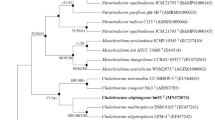Abstract
A novel Gram-strain-negative, rod-shaped, non-flagellated, non-gliding, beige-pigmented and aerobic bacterium, designated strain UJN715T, was isolated from rhizosphere soil of Alhagi sparsifolia obtained from Alear city, located in Xinjiang province, PR China. Growth optimally occurred at 37 °C, pH 6.5–7.5, and 0–3% (w/v) NaCl. Phylogenetic analysis based on 16S rRNA gene sequence showed that strain UJN715T belonged to the genus Chelativorans, with the highest sequence similarity to Chelativorans multitrophicus DSM 9103 T (97.7%). Genome sequencing revealed a genome size of 5 702 301 bp and a G + C content of 64.1 mol%. The ANI, POCP and the dDDH between strain UJN715T and C. multitrophicus DSM 9103 T were 76.2%, 49.3%, and 20.5%, respectively. The prediction result of secondary metabolites based on genome showed that the strain UJN715T contained one cluster of ectoine production, one cluster of non-ribosomal peptide synthetase (NRPS), one cluster of type I polyketide synthases (TIPKS), one cluster of bacteriocin, one cluster of TfuA-related, one cluster of N-acetylglutaminylglutamine amide (NAGGN) production, one cluster of terpene production, two clusters of homoserine lactone (Hserlactone) production. The major respiratory quinone was Q-10. The major fatty acids were iso-C17:0, C18:0 and C19:0 cyclo ω8c and its polar lipids consisted of phosphatidylethanolamine, phosphatidylglycerol, phosphatidylcholine, phospholipids, unknown lipids, diphosphatidylglycerol, aminoglycolipid, unidentified aminophospholipids. On the basis of these data, strain UJN715T is considered to represent a novel species of the genus Chelativorans, for which the name Chelativorans alearense sp. nov. is proposed. The type strain is UJN715T (= KCTC 72856T = CCTCC AB2019378T).

Similar content being viewed by others
Abbreviations
- ANI:
-
Average nucleotide identity
- dDDH:
-
Digital DNA–DNA hybridization
- HPLC:
-
High-performance liquid chromatography
- POCP:
-
Percentage of conserved proteins
- MIDI:
-
Microbial Identification System
- KCTC:
-
Korean Collection for Type Cultures
- CCTCC:
-
China Center for Type Culture Collection
- TLC:
-
Thin layer chromatography
References
Doronina NV, Kaparullina EN, Trotsenko YA, Nörtemann B, Bucheliwitschel M et al (2010) Chelativorans multitrophicus gen. nov., sp. nov. and Chelativorans oligotrophis sp. nov., aerobic EDTA-degrading bacteria. Int J Syst Evol Microbiol 60:1044–1051
Parte AC (2013) LPSN—list of prokaryotic names with standing in nomenclature. Nucleic Acids Res 42:D613–D616
Kämpfer P, Arun AB, Busse HJ, Zhang ZL, Glaeser SP (2015) Chelativorans intermedius sp. nov. and proposal to reclassify Thermovum composti as Chelativorans composti comb. nov. Int J Syst Evol Microbiol 65:1646–1652
Meng D, Liu YL, Li RR, Gu PF, Fan XY et al (2019) Chryseobacterium binzhouense sp. nov., isolated from activated sludge. Int J Syst Evol Microbiol 70:618–623
Yoon SH, Ha SM, Kwon S, Lim J, Kim Y et al (2017) Introducing EzBioCloud: a taxonomically united database of 16S rRNA gene sequences and whole-genome assemblies. Int J Syst Evol Microbiol 67:1613–1617
Kumar S, Stecher G, Tamura K (2016) MEGA7: molecular evolutionary genetics analysis version 7.0 for bigger datasets. Mol Biol Evol 33:1870–1874
Meier-Kolthoff JP, Auch AF, Klenk HP, Göker M (2013) Genome sequence-based species delimitation with confidence intervals and improved distance functions. BMC Bioinform 14:60
Qin QL, Xie BB, Zhang XY, Chen XL, Zhou BC et al (2014) A proposed genus boundary for the prokaryotes based on genomic insights. J Bacteriol 196:2210–2215
Blin K, Shaw S, Steinke K, Villebro R, Ziemert N et al (2019) antiSMASH 5.0: updates to the secondary metabolite genome mining pipeline. Nucleic Acids Res 47:W81–W87
Bowman JP (2000) Description of Cellulophaga algicola sp. nov., isolated from the surfaces of Antarctic algae, and reclassification of Cytophaga uliginosa (ZoBell and Upham 1944) Reichenbach 1989 as Cellulophaga uliginosa comb. Int J Syst Evol Microbiol 50:1861–1868
Cerny G (1978) Studies on the aminopeptidase test for the distinction of gram-negative from gram-positive bacteria. Eur J Appl Microbiol 5:113–122
Liu YL, Meng D, Li R-R, Gu P-F, Li Q (2019) Rhodoligotrophos defluvii sp. nov., isolated from activated sludge. Int J Syst Evol Microbiol 69:3830–3836
Institute C (2007) Performance standards for antimicrobial susceptibility testing. Twenty-Second Informational Supplement, vol 31, pp 76–79
Kroppenstedt RM (1982) Separation of bacterial menaquinones by HPLC using reverse phase (RP18) and a silver loaded ion exchanger as stationary phases. J Liq Chromatogr 5:2359–2367
Sasser M (1990) Identification of bacteria by gas chromatography of cellular fatty acids. MIDI Tech Note 101:1–6
Komagata K, Suzuki KI (1988) Lipid and cell-wall analysis in bacterial systematics. Methods Microbiol 19:161–207
Richter M, Rosselló-Móra R (2009) Shifting the genomic gold standard for the prokaryotic species definition. Proc Natl Acad Sci USA 106:19126–19131
Acknowledgements
This work was supported by the National Natural Science Foundation of China (32070111, 31870105, 31741007), and the Training Foundation of Shandong Natural Science Foundation (ZR2019PEE030).
Author information
Authors and Affiliations
Contributions
MD, LWM, and LQ designed research and project outline. LYL, GFP, and HZS performed isolation, deposition, and identification. JY, FXY, DZJ, LWM, and LQ drafted the manuscript. All authors read and approved the final manuscript.
Corresponding authors
Ethics declarations
Conflict of interests
The authors declare that they have no conflict of interest.
Informed Consent
Informed consent was obtained from all individual participants included in the study.
Human and Animal Rights
This article does not contain any studies with animals performed by any of the authors.
Additional information
Publisher's Note
Springer Nature remains neutral with regard to jurisdictional claims in published maps and institutional affiliations.
New Taxa—Proteobacteria
The GenBank accession number for the 16S rRNA gene sequence of Chelativorans alearense UJN715T is MN744315. The whole-genome shotgun project of strain UJN715T has been deposited at DDBJ/ENA/GenBank under the accession number WQNI00000000. The version described in this paper is version WQNI00000000.
Supplementary Information
Below is the link to the electronic supplementary material.
Rights and permissions
About this article
Cite this article
Meng, D., Liu, YL., Gu, PF. et al. Chelativorans alearense sp. nov., A Novel Bacterial Species Isolated From Soil in Alear, China. Curr Microbiol 78, 1656–1661 (2021). https://doi.org/10.1007/s00284-021-02428-6
Received:
Accepted:
Published:
Issue Date:
DOI: https://doi.org/10.1007/s00284-021-02428-6




